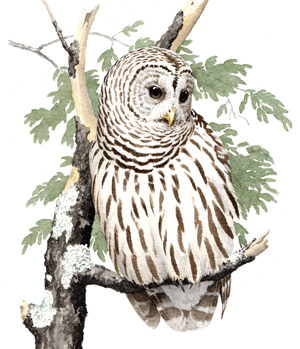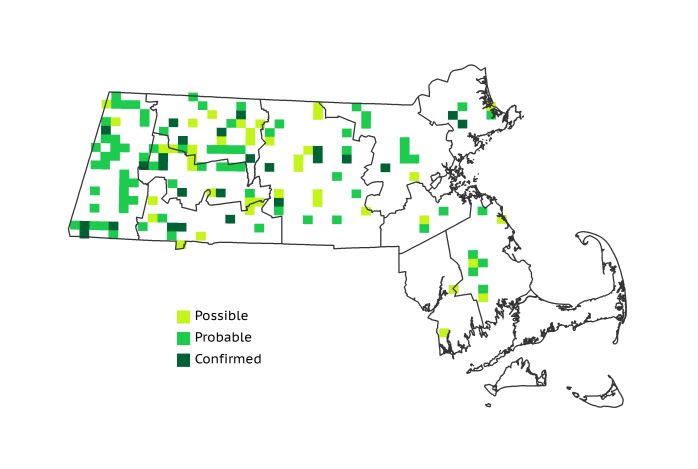Find a Bird
Barred Owl
Strix varia

Fairly widespread and strongly increasing

“It has a very smooth and handsome round head, a brownish gray. Solemnity is what they express, – fit representatives of the night.” – Henry David Thoreau
Many nighttime travelers in the New England woods have been asked, who cooks for you, who cooks for you all? by a Barred Owl. Its deep, resonant voice carries well in the moist forested woodlands that the species prefers during the breeding season. Even a poor imitation can sometimes attract Barred Owls to within viewing range, but for the most part these shy owls prefer to remain in the forest interior. The return of beavers to the Massachusetts landscape and the widespread regeneration of the state’s forests have created favorable conditions for Barred Owls.
Historic Status
A century ago, as now, a winter flight of Barred Owls always attracted great attention from birders and naturalists. Perhaps even rarer, summer reports of the bird’s appearance historically elicited lengthy and excitable letters to publications like the Bulletin of the Massachusetts Audubon Society. “Mount Vernon St., Boston, No. 65, has an owl,” wrote Chief Justice John A. Aiken in 1920. “During the day the owl was within easy observation, resting on windowsills…What Brewster says in his ‘Birds of the Cambridge Region’ seems to indicate the Barred Owl as the visitor” (Aiken 1920). The scarcity of the birds at that time can likely be attributed to a dearth of proper wooded wetland habitat across the state, as farmland still dominated much of the landscape nearly a century ago. But as the forests began to grow back and beavers were once again making themselves at home in the Massachusetts countryside, Barred Owls began to colonize the more wooded regions of the Commonwealth.
Atlas 1 Distribution
The combined blocks of the Berkshire Transition, Lower Berkshire Hills, Berkshire Highlands, and Marble Valleys ecoregions accounted for 36% of all Barred Owl records in Atlas 1, likely due to their extensive areas of forest and recovering beaver numbers. The Worcester and Lower Worcester Plateau ecoregions had fewer Barred Owls than the regions to the west, except for the Connecticut River Valley, and the species became progressively less widespread farther east. The Bristol/Narragansett Lowlands and the Coastal Plains had scattered records of breeding Barred Owls, mostly in areas of wet forests dominated by Red Maple and other species that prefer “wet feet.” Despite the species’ general proliferation, there were no Atlas 1 records from the Cape and Islands, although the scrubby, pitch pine forests of the southeastern part of the state have never been a stronghold for Barred Owls.
Atlas 2 Distribution and Change
While Great Horned Owls nearly doubled their distribution in Massachusetts between the two Atlas projects, Barred Owls more than tripled theirs. Wherever Barred Owls nested in Atlas 1, they expanded their footprint in Atlas 2. Growth was slowest in the Bristol/Narragansett Lowlands, but the species made new incursions into Barnstable County, including invading the Upper Cape. Barred Owls expanded their distribution in each one of the 13 ecoregions during Atlas 2.
Atlas 1 Map

Atlas 2 Map

Atlas Change Map

Ecoregion Data
Atlas 1 | Atlas 2 | Change | ||||||
Ecoregion | # Blocks | % Blocks | % of Range | # Blocks | % Blocks | % of Range | Change in # Blocks | Change in % Blocks |
Taconic Mountains | 7 | 43.8 | 4.9 | 12 | 48.0 | 2.7 | 4 | 26.7 |
Marble Valleys/Housatonic Valley | 17 | 43.6 | 12.0 | 21 | 53.8 | 4.8 | 4 | 10.3 |
Berkshire Highlands | 12 | 21.8 | 8.5 | 41 | 74.5 | 9.3 | 27 | 50.9 |
Lower Berkshire Hills | 8 | 28.6 | 5.6 | 18 | 58.1 | 4.1 | 9 | 33.3 |
Vermont Piedmont | 4 | 23.5 | 2.8 | 13 | 76.5 | 3.0 | 6 | 50.0 |
Berkshire Transition | 14 | 36.8 | 9.9 | 21 | 52.5 | 4.8 | 6 | 19.4 |
Connecticut River Valley | 11 | 19.6 | 7.7 | 25 | 38.5 | 5.7 | 9 | 18.8 |
Worcester Plateau | 18 | 23.1 | 12.7 | 73 | 83.0 | 16.6 | 24 | 50.0 |
Lower Worcester Plateau | 16 | 21.6 | 11.3 | 52 | 65.0 | 11.8 | 20 | 37.0 |
S. New England Coastal Plains and Hills | 26 | 9.6 | 18.3 | 135 | 47.7 | 30.7 | 84 | 37.2 |
Boston Basin | 1 | 1.8 | 0.7 | 7 | 12.5 | 1.6 | 6 | 10.9 |
Bristol and Narragansett Lowlands | 8 | 7.5 | 5.6 | 17 | 14.9 | 3.9 | 9 | 8.9 |
Cape Cod and Islands | 0 | 0.0 | 0.0 | 5 | 3.5 | 1.1 | 4 | 3.3 |
Statewide Total | 142 | 14.7 | 100.0 | 440 | 42.4 | 100.0 | 212 | 25.6 |
Notes
The Barred Owl shows a significant increasing Breeding Bird Survey (BBS) trend in the Eastern US BBS region.



